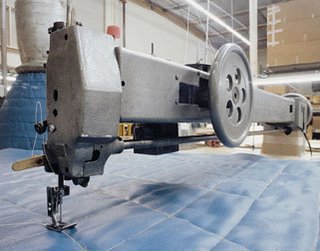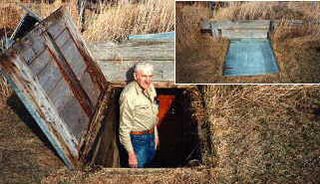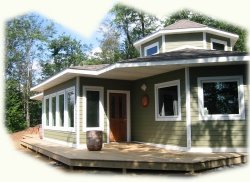New Home Insulation: Extreme to Basic
The space shuttle must insulate from ice-cold space to infernal re-entry up to 3,000 degrees F. You might have insulation blankets ("batts") in your current home and the shuttle uses up to 7 layers of insulating blankets (unfortunately, I have not been able to find the effective R value (standard measure of insulating effect) of shuttle insulation).
A quilting machine makes insulation blankets for the space shuttle:

The simplest insulator is the earth itself (ever walk into a cool basement during summer?). The root cellar (a.k.a. "fruit cellar") below in Alberta, Canada has bare earth walls and the top door is simply 3/4-inch rough lumber covered in tin with no other insulation, yet with doors closed the inside hovers from above freezing (no exact temperature taken) in winter to 50 degrees F in summer despite outside extremes from -40 to +90. In other words, dirt--which has no moving parts to break--and less than an inch of wood--which is common outside the Middle East--keep the inside at least 75 degrees warmer than the outside in winter and 40 degrees cooler in summer without a penny spent on heating fuel or air-conditioning electricity.

The money to add another 25 degrees over this passive, natural level for comfortable living is modest compared to the cost of insulation or heating in typical new home construction. An earth-sheltered home built on the walk-out-basement style can look attractive and conventional (see below). Microsoft founder Bill Gates owns an earth-sheltered home even though he probably does not worry about his home heating bill.
 This discussion gives you an idea of baseline needs and from there you can decide how much money you want to burn for "active" heating and cooling. It also might be possible with a higher initial infrastructure cost to achieve zero net energy cost from Passive Annual Heat Storage (PAHS).
This discussion gives you an idea of baseline needs and from there you can decide how much money you want to burn for "active" heating and cooling. It also might be possible with a higher initial infrastructure cost to achieve zero net energy cost from Passive Annual Heat Storage (PAHS).




1 Comments:
palm angels outlet
nike sb dunks
golden goose outlet
golden goose outlet
goyard outlet
kd shoes
fear of god essentials
jordan shoes
off white hoodie outlet
kd 15
Post a Comment
<< Home